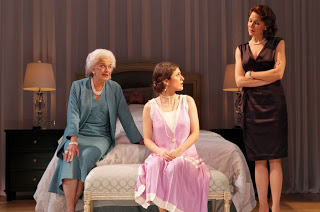Review: Three Tall Women by Edward Albee. Directed by Alison Narver. Scenic Design by Matthew Smucker. With Megan Cole, Suzanne Bouchard, Alexandra Tavares, Nick Garrison. Now through Nov 28 at Seattle Rep.
| (l-r) Megan Cole, Alexandra Tavares, and Suzanne Bouchard in Edward Albee’s Three Tall Women. Photo by Chris Bennion. |
I’ve kvetched of late about the quality of some big name plays on Seattle stages including Seattle Rep’s current main stage production of Yazmina Reza’s gawd awful “God of Carnage”, which inexplicably has won numerous awards including the Tony Award. That won’t be the case with the Rep’s OTHER production, on the smaller Leo K. stage, Edward Albee’s 1991 drama, “Three Tall Women”. It’s a powerful, vital, beautifully written work of art by the most artistically important American playwright of the last 50 years and stands as a piece of great literature. And, this production, under the direction of Alison Narver, lives up to the promise of Albee’s prose; it’s a gorgeously designed, lovingly directed and deliciously acted night of theater. If size were relevant to artistry, the Rep should swap the “tall ladies” for the boorish yups in “Carnage”, which wastes four talented actors in a drecky boulevard “farce” while “Three Tall Women” gives four different, but equally talented actors, the chance to create work in a classic piece of art. But, life, and commerce, aren’t always fair.
Act II opens with a very realistic looking mannequin of “A” in the bed, and the actresses from the first act all playing the character of “A” at different ages in her life, “C” at age 26, “B” at 52, and the actress that played the 92 year old “A” in Act I, is now portraying the character at a slightly younger age, prior to her decline. “C” is young and optimistic and shattered to discover that her life promises to be full of heartache and pain. “B” is pragmatic and slightly bitter, but protests to the “C” that there will be good times as well as bad. But, “B” is also bitter about her relationship with her gay son, and shocked to learn from “A” that they will eventually make some peace with one another as her death approaches. The son, (named “Boy” in the script) appears to sit at the bedside of his dying mother but never speaks. Each aspect of the woman gets her moment to take center stage but it’s “A” who has the final lines of the play as the three women discuss their “happiest moments” and “A” leaves us with, “”That’s the happiest moment. When it’s all done. When we stop. When we can stop.”
Everything about this production earns high praise but let us begin with Matthew Smucker’s beautifully designed and executed set, the luxurious but classically simple bedroom of “A”. The proscenium was framed, like a painting, to focus the attention on the surreality of the drama on stage, and the walls of the bedroom were all sheer, white draperies that rippled when the actors walked near them and they reflected the colors of the lighting….it was a delicious fever dream of a set that nestled someplace between plausible reality and the fractured subconsciousness of the dying woman. It was a beautifully realized set and Mr Smucker probably just earned himself a slew of awards nominations for it.
High praise also, for Allen Hahn’s dramatic lighting, Melanie Taylor Burgess’s immaculate costumes and the subtle and effective sound design by Paul James Prendergast. And, it was all executed under the astute direction of Allison Narver, who directed with a clean, carefully choreographed but organic purpose of intent.
As the only non-tall and non-woman in the cast, Nick Garrison, doesn’t have any lines but has the difficult task of imbuing his “Boy” with dignity and meaning in what is a symbolic background role, but he made the character important with his physicality. Alexandra Tavares as the youngest of the women, was excellent at portraying the youth, vitality and naivete of the character but was equally strong at playing the bitterness and fear of her character’s future. And, Suzanne Bouchard as the middle of the three women, seems a bit too young to play 52, but her performance was strong and the center point of the play and Ms Bouchard was excellent at conveying not only her character’s anger and bitterness, but her genuine wit and charm.
| Megan Cole as “A” in Three Tall Women. Photo by Chris Bennion. |
But the star of “Three Tall Women” is always the actress playing “A” and Megan Cole gives a powerful performance in a very demanding role that requires learning pages and pages of complicated dialogue that consists of numerous regressions, loops and sudden changes in mood and character and reflects the tortured speaking patterns and memory loss of an adult suffering from dementia and senility. It’s a very difficult part to learn and I’m sad to report that Ms Cole did have some issues with lines on opening night, and had to be prompted on more than one occasion by the stage manager. It was obviously a painful moment for the actress, her fellow performers and for the audience, but the lapses did seem in character for the part. It did add tension to the rest of the performance, which was regrettable as it detracted from the overall enjoyment of the play. But, Ms Cole was fine otherwise in the role, giving strong dimension to a character that could be considered cold and unlikeable, and shaded her performance with warmth, humor and understanding. Hopefully, she can conquer those “line” demons and claim the role as her own. Both she and the role deserve it.
Who’s this for? Anyone who appreciates brilliant stage artistry and stage craft. Albee fans. It’s a must see play.
– Michael Strangeways












